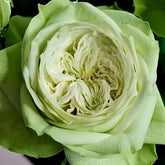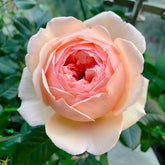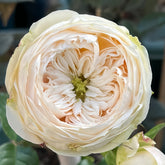Coffee Grounds as Rose Fertilizer: A Natural Guide for Vibrant Roses
by
SmithZoe
19 Oct 2025
For rose gardeners, finding the perfect rose fertilizer is key to growing lush bushes and abundant blooms. If you’re a coffee lover, you might wonder: Can coffee grounds double as a natural rose fertilizer? The short answer is yes—but with a few crucial caveats. In this guide, we’ll break down how to use coffee grounds effectively as rose fertilizer, avoid common mistakes, and help your roses thrive with this eco-friendly option.
Can Coffee Grounds Really Work as Rose Fertilizer?
Let’s start with the basics: Coffee grounds can be an excellent rose fertilizer, but they need proper preparation first. Raw, unprocessed coffee grounds contain caffeine and other compounds that can harm your roses—stunting growth or even damaging roots. However, when prepared correctly, coffee grounds transform into a nutrient-rich, organic rose fertilizer that roses love.
Roses benefit from slightly acidic soil, and coffee grounds (when aged or processed) add a gentle acidity that complements their needs. Plus, they’re packed with organic matter that improves soil structure, retains moisture, and feeds beneficial microbes—all while acting as a budget-friendly rose fertilizer you can get for free!
How to Prepare Coffee Grounds for Rose Fertilizer
To turn coffee grounds into safe, effective rose fertilizer, follow these simple preparation methods. Skipping this step can do more harm than good, so don’t rush the process:
1. Dry the Coffee Grounds Thoroughly
Spread fresh coffee grounds on a baking sheet or tray and let them air-dry for 3–5 days. Drying removes excess moisture (which prevents mold) and starts breaking down some of the harsh compounds. Once dry, store them in an airtight container until you’re ready to use them as rose fertilizer.
2. Compost Coffee Grounds (Best for Long-Term Rose Fertilizer)
Mix dry coffee grounds into your compost pile with other organic materials like leaves, grass clippings, or vegetable scraps. Composting fully breaks down caffeine and balances the acidity, creating a well-rounded rose fertilizer rich in nitrogen, phosphorus, and potassium—key nutrients roses crave. Let the compost mature for 2–3 months before applying to your rose beds.
3. Mix with Other Organic Matter
If you don’t compost, mix dry coffee grounds with coconut coir, aged manure, or leaf mold in a 1:3 ratio. This dilutes the coffee grounds’ acidity and creates a mild, safe rose fertilizer that won’t shock your plants.
Key Tips for Using Coffee Grounds as Rose Fertilizer
Even the best rose fertilizer can backfire if used incorrectly. Follow these rules to get the most out of coffee grounds:
1. Use in Moderation (Avoid Over-Acidity)
The biggest risk of using coffee grounds as rose fertilizer is over-acidifying the soil. Roses prefer slightly acidic to neutral soil (pH 6.0–7.0), and too many coffee grounds can drop the pH too low, causing yellowing leaves or stunted growth. Stick to 1–2 cups of prepared coffee grounds per rose bush, applied 2–3 times per growing season.
2. Apply Correctly
Sprinkle the prepared coffee grounds around the base of your rose bush, keeping them 2–3 inches away from the stem (to avoid root burn). Lightly work them into the topsoil or cover with a thin layer of mulch—this helps the nutrients slowly release as rose fertilizer without washing away in rain.
3. Match to Your Rose’s Needs
Not all roses have the same needs, and some may benefit more from coffee grounds than others. If your soil is already acidic (test with a soil pH kit), use coffee grounds sparingly or skip them entirely. For roses growing in alkaline or neutral soil, coffee grounds make an ideal supplementary rose fertilizer to adjust pH and add nutrients.
Why Coffee Grounds Are a Great Natural Rose Fertilizer
Coffee grounds stand out as rose fertilizer for several reasons, making them a favorite among eco-conscious gardeners:
- Budget-friendly: They’re a waste product from your morning coffee, so you get free rose fertilizer with zero extra cost.
- Organic and sustainable: No synthetic chemicals—just pure organic matter that improves soil health long-term.
- Nutrient-dense: They provide slow-release nitrogen (for leaf growth) and trace minerals that roses need for strong stems and vibrant blooms.
- Pest-deterrent bonus: While not a primary benefit, some gardeners find that coffee grounds repel slugs and snails—common rose pests—adding extra value to this multi-tasking rose fertilizer.
Final Thoughts: Coffee Grounds as Rose Fertilizer
Coffee grounds are a fantastic natural rose fertilizer when prepared and used correctly. By drying, composting, or diluting them, you eliminate the risk of caffeine damage and create a gentle, nutrient-rich option that feeds your roses and improves soil health. Just remember: moderation is key to avoiding over-acidity, and matching the rose fertilizer to your soil’s pH will ensure the best results.
Whether you’re a seasoned rose grower or just starting out, coffee grounds offer an easy, sustainable way to boost your roses’ health. Give this natural rose fertilizer a try, and watch your bushes reward you with bigger, brighter blooms all season long!
Would you like a printable “Coffee Grounds Rose Fertilizer Usage Checklist” to keep track of application times and amounts? It’s a handy tool for ensuring you use this natural rose fertilizer correctly!

















